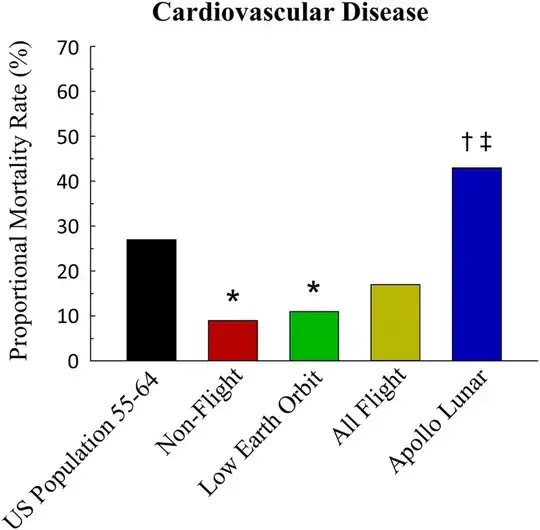Some problems with that article...
A total of 30 astronauts traveled outside the magnetosphere of the earth: three astronauts on ten missions: Apollo 8, 10, 11, 12, 13, 14, 15, 16, and 17. Not all landed on the moon, but all traveled to the moon, outside of the earth's magnetic influence, which is the premise of the article.
The study used seven lunar orbit astronauts, as seven out of those thirty have died. So, not only is the pool small enough to be statistically suspect, other factors such as age of the astronaut are not being considered.
The Apollo astronauts are all very old now, and at an age where heart disease is not unusual, whereas the total pool of astronauts studied includes a high percentage of much younger people, as NASA hired a substantially higher number of astronauts for the large crews for the shuttles plus the much higher number of shuttle missions flown as compared to Mercury, Gemini and Apollo.
This list of astronauts, along with hiring dates, shows the preponderance of much younger non lunar astronauts in the study. During Apollo, there were about 20-25 active astronauts depending on who was retiring and who was being hired, while at the peak of the shuttle years, 2000, there were 109 active astronauts. Same holds true for actual flying astronauts: Apollo had a crew of three and flew 15 missions including spacelab, while the shuttle had a crew of 5-7, and flew over 120 missions. So the non lunar astronauts studied tend to be much younger than the lunar orbit astronauts, due to the simple fact that we haven't sent a crew to the moon since 1972.
This PDF was the most complete age related heart disease study I could find. It shows under one percent for under 40, around six percent for middle aged people, rising to around 20 percent for 60+, and 32% for 80 and older... the lunar orbit astronauts are all older than 60, and a few are around 80. That should have been a big factor in any such study. It is not considered in this one.
Also not considered is the untimely and premature deaths of 14 non moon mission astronauts, on Apollo 1, and the Challenger and Columbia disasters. Those deaths were not natural and not related to health conditions, so it can't be determined if any of them would also have suffered from heart disease had they not died in the losses of the spacecraft. As the total non lunar flying astronauts analyzed was 37, over one third of that study group died in those three accidents, which certainly would have thrown off any conclusions since the study was related to long term health effects of lunar (or further) space travel.
So to get back to the original question - are lunar astronauts dying of heart disease at a higher rate? It is impossible to determine from that rather shoddy piece of work.
